| Article ID | Journal | Published Year | Pages | File Type |
|---|---|---|---|---|
| 257059 | Construction and Building Materials | 2015 | 8 Pages |
•Different concrete mix proportioning design methods were environmentally evaluated.•Conventional and recycled concretes of equivalent sets of properties were assessed.•The novel Equivalent Mortar Volume method achieves the best performance.•Cement is the most influential material on most of the analysed impact categories.•The novel approach represents a solution to other method’s environmental problems.
The objective of this investigation is to environmentally evaluate three concrete design methods through a Life Cycle Assessment using the methodology of the Institute of Environmental Sciences (CML), from Leiden University, one of the most commonly applied in practice. Included is a novel method for designing recycled aggregate concretes, named Equivalent Mortar Volume. The evaluation is done by comparing certain key life cycle stages of four concretes, two designed through the proposed method and two others designed through widely known methods. These experimentally assessed concretes have equal sets of properties in terms of mechanical resistance, durability, and workability. According to the calculated emission quantities, concretes designed using the novel method show better environmental performance than their counterparts in all of the selected impact categories.
